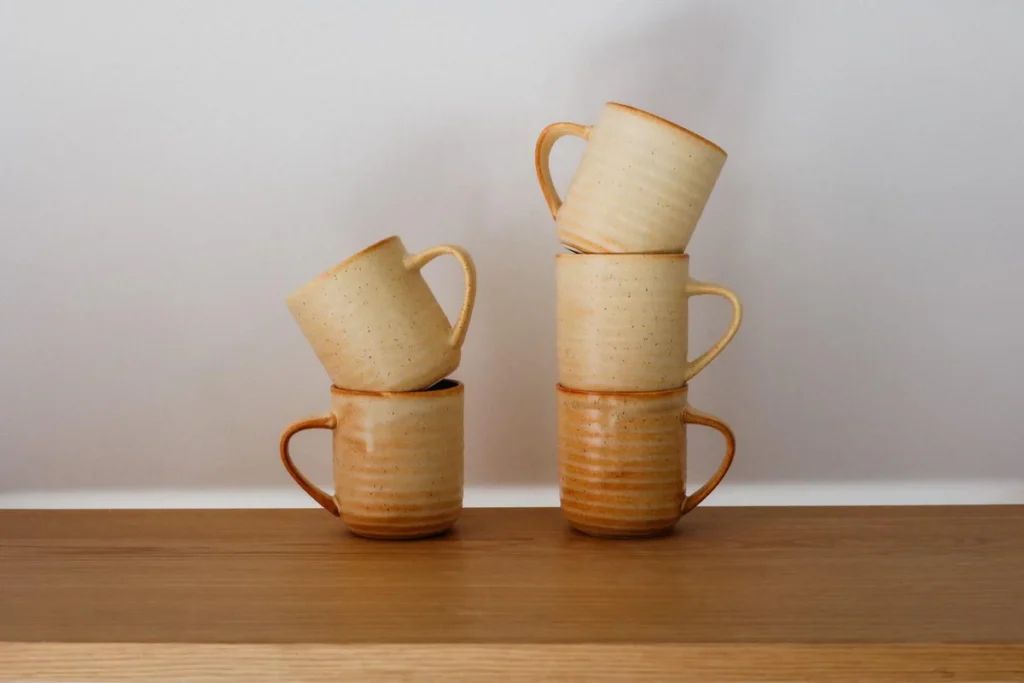Imagine this: your morning coffee or evening tea, held in a mug that isn’t just another vessel, but a piece of art shaped by human hands, infused with character, and carrying a story all its own. That’s the timeless appeal of handmade mugs.
Unlike mass-produced drinkware, which often feels uniform and impersonal, each handcrafted mug is unique: a blend of form, function, and artistry that turns an everyday ritual into something special.
In this guide, we’ll walk you through the fascinating world of handmade drinkware. You’ll learn how to spot genuine craftsmanship, discover the different materials and styles that shape their character, and gain insights on how to choose a mug that truly reflects your personality and lifestyle.
By the end, you’ll not only know how to select a mug that feels right in your hands, but you’ll also understand how to care for it properly, ensuring it remains a lasting companion in your daily rituals. Most importantly, you’ll come away with a deeper appreciation for the artisans whose passion and skill bring these everyday treasures to life.
What Defines a Truly Handmade Mug?
When browsing shelves or online stores, it can be difficult to distinguish a genuinely handmade mug from a mass-produced imitation. Understanding the key markers of craftsmanship empowers you to choose a piece that reflects authenticity, artistry, and enduring quality.
The Mark of the Maker
One of the clearest signs of a truly handmade mug is the signature of the artisan. Many potters leave subtle identifiers such as a stamped logo, engraved initials, or even a distinctive glazing style that serve as their mark of authenticity. Unlike mass-produced items that appear identical, these marks offer a personal connection between maker and user.
Expert Insight: According to pottery guilds and artisan collectives, an authentic maker’s mark is a strong indicator that the mug was shaped, glazed, and fired by hand rather than pressed out on a production line.
Subtle Imperfections as Character
In a world that prizes uniformity, it’s important to remember that imperfections are proof of the human touch. Handmade mugs may feature slight variations in glaze, an uneven rim, or minor differences in weight from one piece to another. Far from being flaws, these variations are what make each mug truly unique.
Pro Tip: Embrace Imperfections – A glaze drip, a tiny asymmetry, or a thumbprint in the clay are all signs of authenticity. They don’t diminish the piece; they tell the story of the mug’s creation.
The Process vs. the Production Line
Handmade pottery follows time-honored techniques such as throwing clay on a wheel, hand-building, or slip casting in small batches. Each method requires patience, skill, and years of refinement. By contrast, mass production relies on molds, uniform glazes, and industrial kilns designed for speed and identical output.
When you hold a handmade mug, you’re holding the outcome of hours sometimes days of shaping, drying, glazing, and firing. This investment of time and artistry creates a sensory connection that factory-made pieces simply can’t replicate.
Artisan Storytelling & Visual Immersion
Every handmade mug carries a story the artisan’s creative vision, the cultural traditions of pottery, and the tactile process of crafting something from earth and fire. Many makers share these stories through artist profiles, workshops, or behind-the-scenes photos, helping you connect with the craft on a deeper level.
Why This Matters to You
If you’ve ever hesitated while shopping, unsure whether a piece was truly handmade or just marketed that way, knowing these signs helps you buy with confidence. You’ll avoid imitations, support genuine artisans, and bring home a mug that enhances not just your coffee or tea, but the entire ritual of drinking it.
Exploring the World of Handmade Mug Materials
Choosing a handmade mug isn’t just about style it’s also about material. The clay, glass, wood, or metal used in its creation directly impacts not only how the mug looks and feels, but also how it performs in daily use. Understanding the strengths and limitations of each material ensures you find a piece that perfectly fits your lifestyle and beverage rituals.
Common Materials & Their Characteristics
Stoneware
Stoneware is one of the most popular materials for handmade mugs. Fired at high temperatures, it creates a dense, durable finish that retains heat well. Its earthy look and wide range of glazing options make it versatile for both rustic and modern settings.
Porcelain
Known for its refined elegance, porcelain is crafted from fine, white clay and fired at extremely high temperatures. The result is a non-porous, smooth, and often slightly translucent body. While delicate in appearance, high-quality porcelain is surprisingly strong, though it remains more fragile than stoneware.
Earthenware
Earthenware is one of the oldest forms of pottery, fired at lower temperatures. It has a more porous structure, which often requires glazing, and carries a charmingly rustic look. Many artisans use earthenware for hand-painted or decorative finishes, making it a favorite for collectors and display pieces.
Hand-Blown Glass
Glass mugs offer a modern, lightweight alternative that showcases the color and texture of your beverage. They play beautifully with light, especially for layered drinks like lattes or iced teas. However, they retain heat poorly and require careful handling.
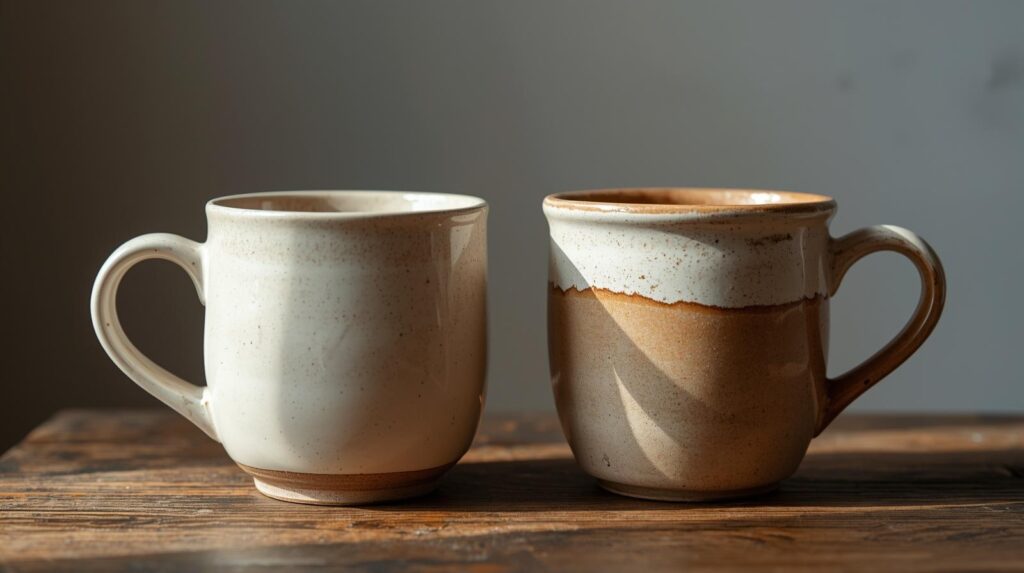
Unique Materials (Wood, Metal, Mixed Media)
- Wood mugs are prized for their natural grain and insulating properties, but they require special care (regular oiling, no dishwashers or microwaves).
- Metal mugs, often insulated, are virtually unbreakable and ideal for travel or outdoor use, though they can impart a metallic taste.
- Mixed media mugs (ceramic combined with wood or metal) offer aesthetic interest but need thoughtful care to preserve all elements.
Material-Specific Considerations
- Microwave & Dishwasher Safety
- Safe: Stoneware, most porcelain (unless gilded), some glass.
- Caution: Earthenware (often hand-wash only), wood, and metal (never microwave).
- Heat Retention
- Best: Stoneware and insulated metal.
- Moderate: Porcelain.
- Weak: Glass and earthenware.
- Durability & Longevity
- Highest: Stoneware and metal.
- Moderate: Porcelain.
- Lowest: Earthenware and glass (fragile, prone to chips).
Expert Tip – Material-Specific Care: Always check artisan recommendations. For example, wood needs oiling to prevent cracking, earthenware prefers gentle hand washing, and metal mugs must avoid microwaves. The right care ensures your handmade piece lasts for years.
Quick Comparison Table
| Material | Key Characteristics | Pros | Cons | Best For |
| Stoneware | Durable, earthy feel, good heat retention | Robust, versatile, wide range of finishes | Can be heavy, may chip if dropped | Everyday use, rustic aesthetics, microwave/dishwasher safe |
| Porcelain | Fine-grained, elegant, non-porous | Lightweight, refined, excellent for teas | Fragile, prone to chipping, hot to touch | Elegant settings, delicate teas, collectors |
| Earthenware | Porous, rustic, often hand-painted | Charming, affordable, artistic expression | Prone to chipping, staining, often hand-wash | Rustic décor, cool drinks, decorative use |
| Glass | Transparent, smooth, modern | Showcases beverage, lightweight, stylish | Fragile, poor heat retention, hot to touch | Iced drinks, latte art, modern décor |
| Wood | Natural grain, lightweight, insulative | Unique aesthetic, comfortable grip | Needs oiling, not microwave/dishwasher safe | Cold beverages, decorative, artisanal look |
| Metal | Durable, insulated, industrial | Unbreakable, great for hot/cold drinks | Metallic taste, not microwave safe | Travel, outdoor use, modern industrial style |
Discovering Your Perfect Handmade Mug Style
Handmade mugs are as diverse as the artisans who create them. With so many styles available, it’s easy to feel overwhelmed when choosing the perfect one. The key is to see a mug not just as drinkware, but as functional art an extension of your personality and a piece of décor that enhances your home.
Below, we explore the most popular aesthetic styles of handmade mugs, complete with descriptions to help you visualize and identify the one that best reflects your taste and lifestyle.
Popular Aesthetic Styles
| Style Name | Defining Characteristics | Best Suited For | Visual Examples (Description) |
| Rustic & Organic | Earthy tones, natural textures, irregular shapes, unglazed elements | Cozy, natural, farmhouse, or bohemian décor | A hand-thrown mug with visible wheel lines, a matte glaze in forest green and clay brown, and an unglazed bottom that feels raw and earthy to the touch. |
| Modern Minimalist | Clean lines, simple forms, often monochromatic or two-tone | Contemporary, sleek, or Scandinavian interiors | A perfectly cylindrical mug with a straight handle, finished in smooth matte black or crisp white, sometimes accented with a thin metallic rim. |
| Traditional & Folk Art | Classic silhouettes, intricate hand-painted patterns, cultural motifs | Vintage lovers or those inspired by cultural heritage | A rounded porcelain mug adorned with blue-and-white floral motifs, echoing Delftware or Chinese pottery traditions, complete with a graceful looped handle. |
| Whimsical & Playful | Unique sculptural handles, unusual shapes, vibrant colors | Eclectic, artistic, or fun-loving personal spaces | A mug shaped like a fox’s head, or a bright multicolored glaze dripping playfully down a wavy-edged rim. Handles may resemble tree branches or geometric forms. |
| Ergonomic & Functional | Comfort-driven design with balanced weight and larger handles | Everyday use and maximum comfort seekers | A generously sized mug with a wide, easy-to-grip handle, a slightly tapered base for stability, and a balanced weight that feels natural in the hand. |
Matching Style to Personality & Décor
Your choice of mug can say as much about you as your choice of furniture or clothing. Rustic styles bring warmth and comfort to farmhouse kitchens, while minimalist designs complement sleek, modern interiors. Whimsical mugs can spark joy in creative spaces, and traditional patterns add timeless charm to vintage-inspired homes.
Think of your mug as a decorative accent as well as a practical item it’s often left on countertops or open shelves, where it adds personality to your living space.
Artisan Storytelling & Visual Immersion
Each artisan interprets these styles differently. One potter’s “rustic” may lean toward rough textures and earthy tones, while another might emphasize organic shapes with modern glazing. Exploring these variations allows you to connect more deeply with the maker’s story, culture, and vision.
Interactive Element: Which Handmade Mug Are You?
To make the process even more engaging, imagine a fun Mug Personality Quiz that helps you discover your ideal style:
- Do you prefer morning coffee in a cozy nook? → Rustic & Organic.
- Is your home filled with sleek furniture and neutral tones? → Modern Minimalist.
- Do you love collectibles and cultural pieces? → Traditional & Folk Art.
- Are you a creative spirit who loves bold statements? → Whimsical & Playful.
- Do you just want a comfortable, reliable everyday mug? → Ergonomic & Functional.
This interactive approach not only helps you narrow down your style but also makes the buying journey more fun and personal.
Understanding Glazes, Finishes, and Food Safety
When choosing a handmade mug, beauty often catches the eye first but safety and durability are just as important. The glaze and finish not only define the mug’s look and feel, but also determine whether it’s safe for everyday use.
The Science of Glazes
Glazes are essentially a type of glass coating applied to pottery. They’re made from a mix of silica, fluxes (to lower melting temperature), and colorants. During firing, the glaze fuses to the clay body, sealing the surface, adding color, and making the mug waterproof.
Types of Glazes
- Glossy Glaze – Smooth, reflective surface that makes colors vibrant and easy to clean.
- Matte Glaze – Soft, non-shiny finish with a more contemporary, understated look.
- Satin/Semi-Matte – A balance between glossy and matte, offering a subtle sheen.
- Textured Glazes – Decorative finishes like:
- Crackle: Fine, web-like lines in the glaze.
- Crystalline: Stunning starburst-like crystal patterns.
- Speckled/Reactive: Natural variations that create depth and uniqueness.
Finishes Beyond Glaze
Not all handmade mugs are fully glazed:
- Unglazed Exteriors – Expose the raw clay for a natural, earthy texture.
- Polished Clay (Burnished) – Smoothed and polished clay that feels silky but remains unglazed.
- Natural Patinas – Over time, certain clays and finishes develop character with use, much like leather.
Food Safety Considerations (Critical!)
While aesthetic appeal matters, food safety is non-negotiable. Glazes not intended for functional use may contain toxic materials like lead or cadmium, which can leach into beverages.
According to the U.S. Food and Drug Administration (FDA), ceramic foodware must comply with strict limits for lead and cadmium release. Reputable artisans and pottery guilds also emphasize using certified food-safe, lead-free glazes for drinkware.
Expert Tip: Identify Food-Safe Glazes
Look for clear labeling such as “food safe” or “lead-free glaze.” If shopping directly from an artisan, don’t hesitate to ask: “Is this mug glazed with food-safe, non-toxic materials?” Ethical makers will be transparent about their materials.
Red Flags to Watch Out For
- Bright red, orange, or yellow finishes in older or imported pottery may contain unsafe pigments.
- Decorative-only mugs are often labeled as not food-safe avoid using them for beverages.
- Unglazed interiors may absorb liquids and harbor bacteria unless explicitly sealed and tested as food-safe.
Why This Matters to You
Choosing a mug with safe, certified glazes ensures you’re not just buying a beautiful piece, but one that protects your health. With the right knowledge, you can enjoy the artistry of handmade pottery while sipping safely every day.
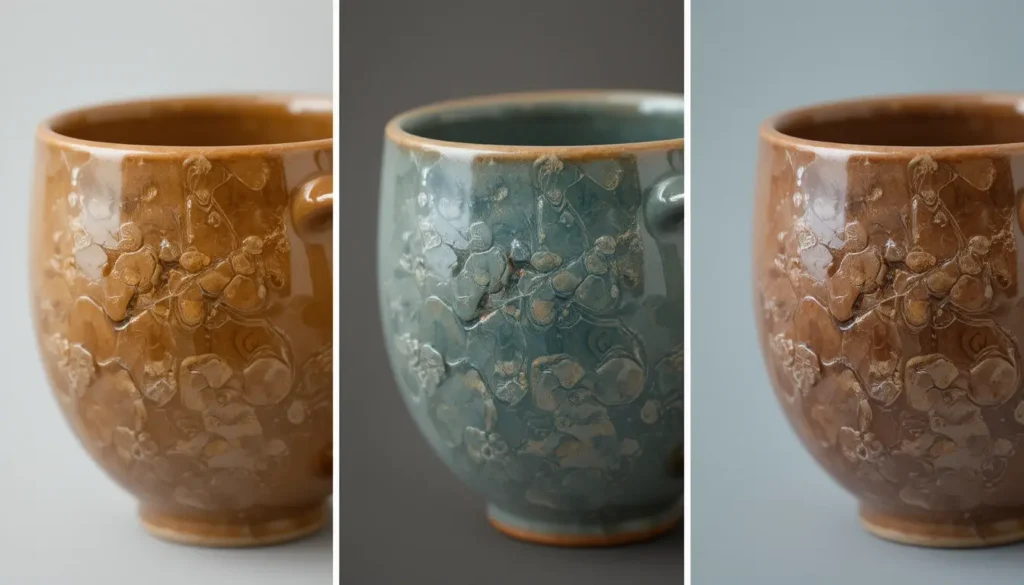
Beyond the Brew: Matching Mugs to Every Occasion & Beverage
Not all mugs are created equal and not all are meant for the same purpose. Just as the right wine glass enhances a vintage, the right handmade mug can elevate your daily ritual, making your favorite beverage more enjoyable. By considering shape, material, and design, you can match each mug to its ideal use, ensuring a richer sensory experience.
Matching Mug to Beverage
| Intended Use / Beverage | Recommended Mug Characteristics | Why It’s Ideal |
| Coffee (Everyday) | Sturdy stoneware, comfortable handle, good heat retention | Stoneware keeps coffee warm longer while its solid feel adds a sense of comfort. A well-balanced handle makes it easy to hold during long morning routines or office breaks. |
| Tea (Aromatic) | Porcelain or fine ceramic, wider mouth, thin rim | The wide opening allows steam and aroma to rise, enhancing the sensory experience of herbal or loose-leaf teas. A delicate rim provides a refined, gentle sip. |
| Espresso / Cortado | Small, thick-walled ceramic or glass, often handle-less | Thick walls retain heat in small servings while keeping the flavor concentrated. A handle-less design encourages you to savor the warmth in your hands, just as in traditional espresso cups. |
| Latte Art | Wider, shallower bowl, smooth interior, comfortable handle | The broad surface allows milk to spread evenly for latte art, while a smooth interior helps the milk flow naturally. The size also keeps the drink warm but not scalding. |
| Soup / Cereal | Large, bowl-like shape, sturdy handle | Perfect for multitasking mugs deep enough for hearty soup or cereal, yet easy to grip. Their versatility makes them favorites for cozy evenings or quick meals. |
| Decorative Display | Unique shapes, intricate glazes, artistic design | These mugs serve as functional art, bringing personality to open shelving or display cabinets. They become conversation starters while reflecting the artisan’s craftsmanship. |
| Office / Desk | Stable base, comfortable handle, optional lid | A wide base prevents accidental spills on papers or laptops, while an ergonomic handle feels natural during long hours. A fitted lid helps retain warmth and prevents interruptions. |
Mugs for Specific Occasions
- Office Use: Choose mugs that balance durability with a polished look. Stability matters as much as aesthetics when coffee is sitting next to electronics.
- Travel: While most handmade mugs are not spill-proof, some artisans create insulated tumblers or mugs with fitted wooden lids ideal for mindful commuting.
- Decorative Display: Collect mugs with sculptural handles, unusual shapes, or reactive glazes to create a visually stunning arrangement.
- Gifting: Handmade mugs make meaningful gifts. Personalize by pairing them with artisan teas, small-batch coffee beans, or even a handwritten note from the maker.
Expert Tip: Gifting Personalization – When gifting a handmade mug, think beyond the object. Pair it with a bag of locally roasted coffee, a tin of herbal tea, or even a cozy linen napkin. The extra touch makes the mug feel like part of a thoughtful ritual, not just a standalone item.
Your Confident Buyer’s Journey: A Checklist for Handmade Mugs
Buying a handmade mug isn’t just a purchase it’s an investment in artistry, authenticity, and daily joy. But with so many “handmade” claims in the market, how can you be sure you’re making the right choice? Use this practical buyer’s checklist to feel confident in your decision.
✅ Handmade Mug Buyer’s Checklist
| Consideration | Why It Matters | Checklist Item (Ask Yourself) |
| Material Choice | Impacts durability, heat retention, and care needs. | Is this mug made of stoneware (durability), porcelain (elegance), or earthenware (rustic charm)? Does it suit my lifestyle? |
| Glaze Safety | Ensures the mug is safe for daily use with food and drink. | Is the glaze labeled food-safe and lead-free? Have I confirmed this with the artisan or product listing? |
| Handle Ergonomics | Affects comfort and ease of use, especially for daily mugs. | Does the handle feel balanced and comfortable in my hand? Is it easy to grip even when the mug is full? |
| Overall Craftsmanship | Indicates artisan skill, structural soundness, and durability. | Are there cracks, chips, or rough spots? Are intentional imperfections charming, but not structural flaws? |
| Size & Capacity | Ensures it holds your preferred amount of beverage. | Does this mug match my daily coffee/tea ritual? (e.g., 250ml for espresso vs. 400ml for a latte) |
| Artisan Signature/Mark | Verifies authenticity and provides provenance. | Can I find an artisan’s mark, studio stamp, or story of origin? Am I buying from a trusted source? |
| Care Instructions | Essential for longevity and avoiding damage. | Is this mug dishwasher/microwave safe? If not, am I willing to hand-wash and care for it properly? |
| Aesthetic & Personal Style | Handmade mugs bring emotional value as well as function. | Does this mug spark joy, fit my home style, and reflect my personality? |
| Price vs. Value | Reflects the artisan’s time, skill, and the uniqueness of the piece. | Does the price make sense given the craftsmanship, time investment, and uniqueness compared to factory mugs? |
Expert Tips to Remember:
- Embrace Imperfections: Subtle variations in glaze, weight, or symmetry are the hallmarks of handmade work.
- Assess Tactile Quality: If possible, hold the mug how does it feel in weight, texture, and balance?
Buy the Story, Not Just the Mug: Knowing the artisan and their process adds meaning to your purchase.
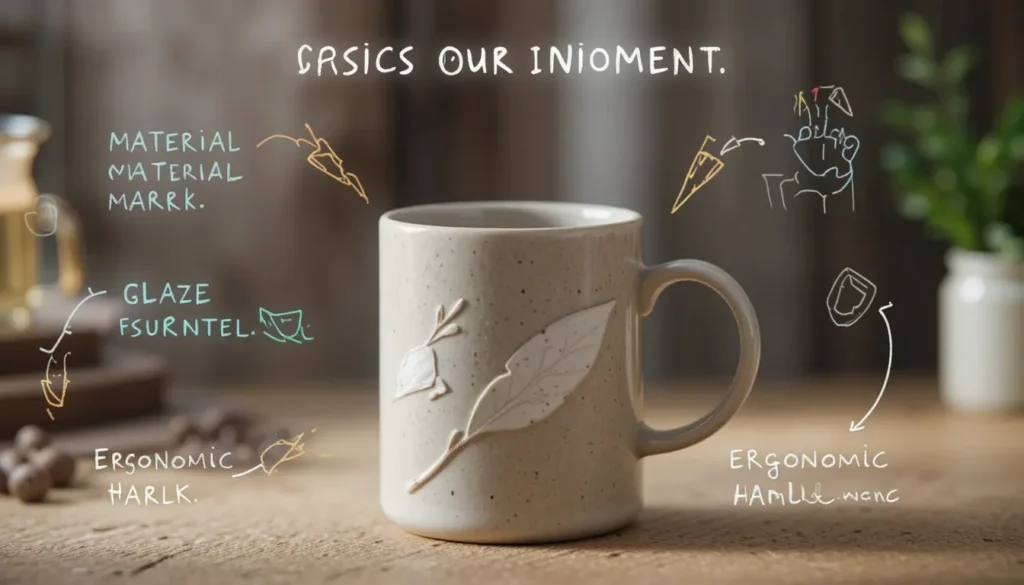
Nurturing Your Treasure: Comprehensive Care for Handmade Mugs
Handmade mugs are more than functional drinkware they’re treasures of craftsmanship. To keep them beautiful and functional for years, it’s important to understand their unique needs. Unlike mass-produced pieces, handmade mugs often feature delicate glazes, organic textures, or natural materials that require thoughtful care.
General Care Principles
🧼 Expert Tip: Gentle Cleaning Practices
- Hand-wash most handmade mugs, especially those with delicate or specialty glazes.
- Avoid abrasive cleaners, steel wool, or scouring pads, as they can scratch the glaze or wear down decorative finishes.
- Use a soft sponge with mild dish soap and lukewarm water.
🔥 Expert Tip: Understand Thermal Shock
- Sudden temperature changes can crack handmade ceramics. For example, never pour boiling water into a cold mug or rinse a hot mug in cold water.
- Always allow mugs to adjust to room temperature before exposing them to heat or cold.
Material-Specific Care Guidelines
Ceramic (Stoneware, Porcelain, Earthenware)
- Stoneware: Generally durable, but avoid extreme temperature shifts.
- Porcelain: Strong but can chip if stacked improperly.
- Earthenware: Softer and more porous hand-wash only, avoid dishwashers.
- Microwave use depends on the glaze check artisan notes or ask directly.
Glass
- Wash with a soft cloth to prevent scratches.
- Avoid abrasive detergents; use vinegar or baking soda paste for clarity.
- Do not expose handmade glass mugs to sudden temperature changes.
Wood
- Never leave soaking in water this can cause swelling and cracking.
- Wipe dry immediately after washing.
- Apply food-safe mineral oil occasionally to maintain its finish and prevent drying out.
Metal (Copper, Brass, or Steel)
- Wash promptly after use to avoid corrosion or staining.
- Avoid harsh acidic cleansers unless recommended by the artisan.
- Dry thoroughly to prevent rust (especially for copper or steel).
Storage Solutions
☕ Expert Tip: Prevent Chips and Cracks
- Avoid stacking fragile mugs directly; if stacking is necessary, use felt pads or paper towels between them.
- Consider hanging mugs on sturdy hooks or displaying them on open shelves.
- For rare or particularly delicate mugs, padded storage drawers or cushioned separators can prevent accidental damage.
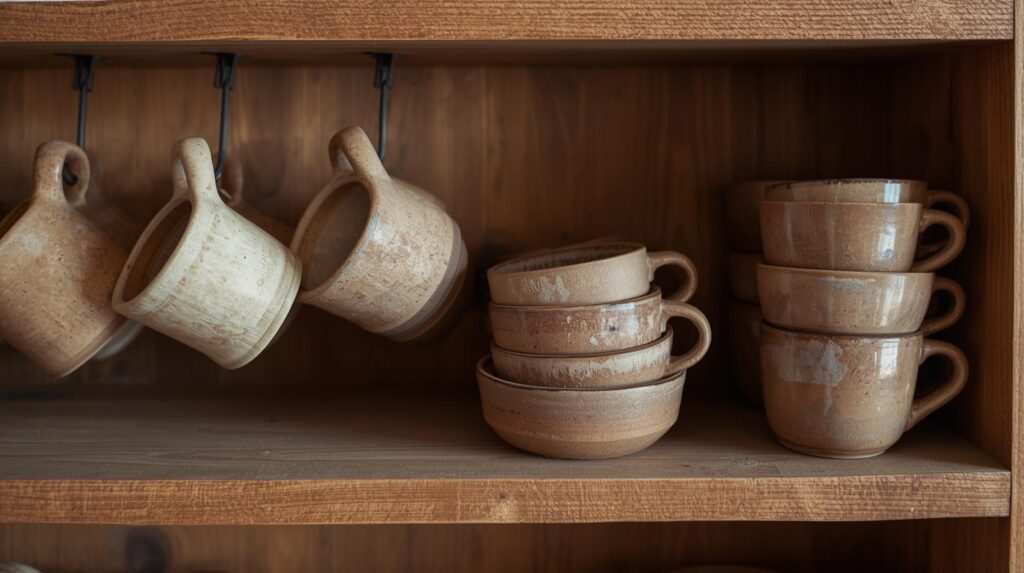
Troubleshooting Common Issues
- Stains (Coffee/Tea): Use a baking soda paste or diluted vinegar to gently scrub without scratching the glaze.
- Chips: Minor chips can be sanded smooth for safe use, or you can embrace them as part of the mug’s character. For deeper damage, consult a ceramic restorer or reserve the piece as decorative.
E-E-A-T Consideration
Referencing authoritative sources such as the American Ceramic Society, or FDA guidelines on food-safe materials adds trust. Many ceramic guilds and pottery experts recommend hand-washing artisan pieces and avoiding thermal shock as the number one rule in extending their lifespan.
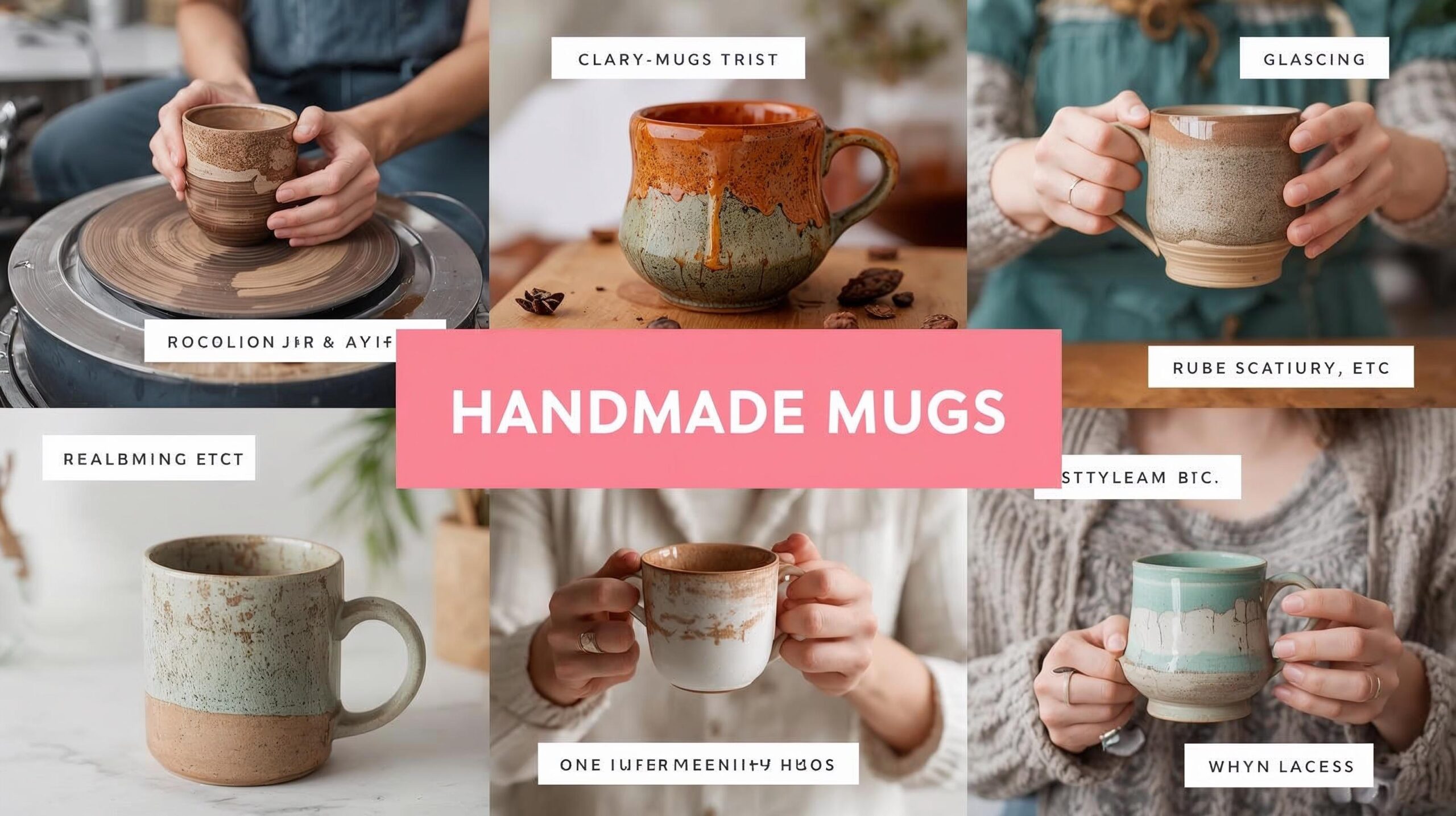
Curated Collection: Top Handmade Mugs You’ll Love (Product Roundup)
Handmade mugs aren’t just drinkware they’re pieces of art infused with character, tradition, and the artisan’s personal touch. To help you choose the right one, we’ve curated a diverse collection of handmade mugs that excel in quality, durability, ergonomic comfort, aesthetic appeal, and artisan credibility. Each recommendation is based on clear criteria:
✔️ Material quality & durability
✔️ Safe, food-grade finishes
✔️ Comfort & usability
✔️ Artisan craftsmanship & story
✔️ Design appeal & uniqueness
🌿 Best Overall Everyday Mug (Stoneware / Ceramic)
Why We Love It: Stoneware mugs are versatile, durable, and hold heat well, making them perfect for daily coffee or tea.
- Material: High-fired stoneware, hand-glazed for warmth and durability.
- Benefits: Dishwasher-safe (in most cases), ergonomic handle, cozy everyday use.
- Artisan Note: Many potters draw inspiration from natural earth tones and textures, giving each mug a rustic yet modern vibe.
✨ Most Elegant & Refined (Porcelain / Fine Glass)
Why We Love It: Perfect for those who enjoy sophistication with their morning ritual. Porcelain and glass offer a lighter, refined touch.
- Material: Translucent porcelain or hand-blown borosilicate glass.
- Benefits: Sleek profile, excellent for green tea or light roasts.
- Artisan Note: Inspired by traditional East Asian tea rituals or modern minimalism.
👉 [Link to artisan shop]
🎨 Unique & Artistic Statement Pieces (Mixed Media / Sculptural)
Why We Love It: These mugs double as conversation starters and decorative accents when not in use.
- Material: Clay + wood, clay + metal, or sculptural ceramic forms.
- Benefits: One-of-a-kind craftsmanship; each piece feels like holding a small sculpture.
- Artisan Note: Many artists experiment with bold glazes, carved textures, or sculptural handles inspired by nature or cultural motifs.
👉 [Link to artisan shop]
☕ Coffee Lover’s Choice
Why We Love It: Designed to enhance coffee’s aroma and depth, with ideal size and heat retention.
- Material: Stoneware or double-walled ceramic.
- Benefits: Wide mouth for aroma release, durable build, comfortable grip.
- Artisan Note: Crafted by potters who are often coffee enthusiasts themselves, fine-tuning shapes for barista-style enjoyment.
👉 [Link to artisan shop]
🍵 Tea Enthusiast’s Delight
Why We Love It: Perfect for savoring delicate flavors with slow, mindful sips.
- Material: Porcelain, stoneware, or hand-glazed earthenware.
- Benefits: Smooth lip, heat-preserving walls, sometimes paired with matching saucers or lids.
- Artisan Note: Many are inspired by Japanese wabi-sabi aesthetics, celebrating subtle imperfections.
👉 [Link to artisan shop]
🌍 Eco-Conscious & Sustainable Picks
Why We Love It: For eco-minded buyers who value natural, renewable, or upcycled materials.
- Material: Locally sourced clay, reclaimed wood handles, natural dyes, or recycled glass.
- Benefits: Low environmental footprint + artisan livelihood support.
- Artisan Note: Many makers highlight eco-friendly processes, such as solar-powered kilns or non-toxic glazes.
💡 Expert Tip for Buyers:
When shopping online for handmade mugs, always check the artisan’s process, food-safety certifications, and whether glazes are lead-free. Authentic handmade mugs often come with care notes from the maker a sign of genuine craftsmanship.
Image
Finding Your Artisan: Where to Buy Authentic Handmade Mugs
One of the biggest challenges for mug lovers isn’t choosing a design it’s finding authentic, high-quality handmade mugs from artisans you can trust. With so many mass-produced lookalikes online, knowing where and how to shop makes all the difference.
Online Marketplaces for Artisanal Goods
If you prefer shopping from home, these platforms offer wide selections of handmade mugs from talented potters worldwide:
- Etsy – A global hub for handmade goods. Look for sellers with verified reviews, detailed product descriptions, and process photos that prove authenticity.
- Artfire & Folksy – Smaller but artisan-focused marketplaces, ideal for discovering unique, lesser-known makers.
- Individual Artisan Websites – Many potters run their own online shops where you can explore full collections and learn more about their process.
💡 Expert Tip: Bookmark your favorite artisans’ shops so you can return for seasonal releases and limited-edition drops.
Supporting Local & Small Businesses
For those who prefer to see and feel mugs before buying, supporting local makers is a deeply rewarding option:
- Pottery Studios & Workshops – Many studios sell directly to visitors and often host open studio days.
- Craft Fairs, Artisan Markets, & Festivals – Great opportunities to meet makers in person, hear their stories, and watch live demonstrations.
- Specialty Boutiques & Galleries – These curated spaces often feature one-of-a-kind, gallery-worthy mugs.
Tips for Verifying Authenticity Online
Before you purchase, keep these quick checks in mind:
- Detailed Product Descriptions – Authentic makers share clay type, glaze information, and care instructions.
- Process Photos & Artisan Bios – Look for behind-the-scenes photos or stories about how the mug was made.
- Customer Reviews – A strong indicator of quality and reliability.
- Return Policies – Reputable artisans or platforms should clearly outline return or exchange options.
E-E-A-T: Trust Through Artisan Voices
To ensure authenticity and food-safety, we turned to real makers for advice:
“If you’re buying online, don’t hesitate to ask questions. Most potters love talking about their work, and if they can’t explain their process, that’s a red flag.”
Leila M., Ceramic Artist (Dubai Pottery Collective)
“Local craft fairs are the best place to start. You’ll not only find authentic mugs but also connect with the community behind them.”
Carlos R., Artisan Potter (Madrid)
Why Buying Authentic Matters
Every purchase is more than a mug it’s a way to support independent artisans, keep traditional craftsmanship alive, and ensure your piece is truly unique. By shopping directly from makers or reputable platforms, you’re investing in artistry, sustainability, and long-lasting quality.
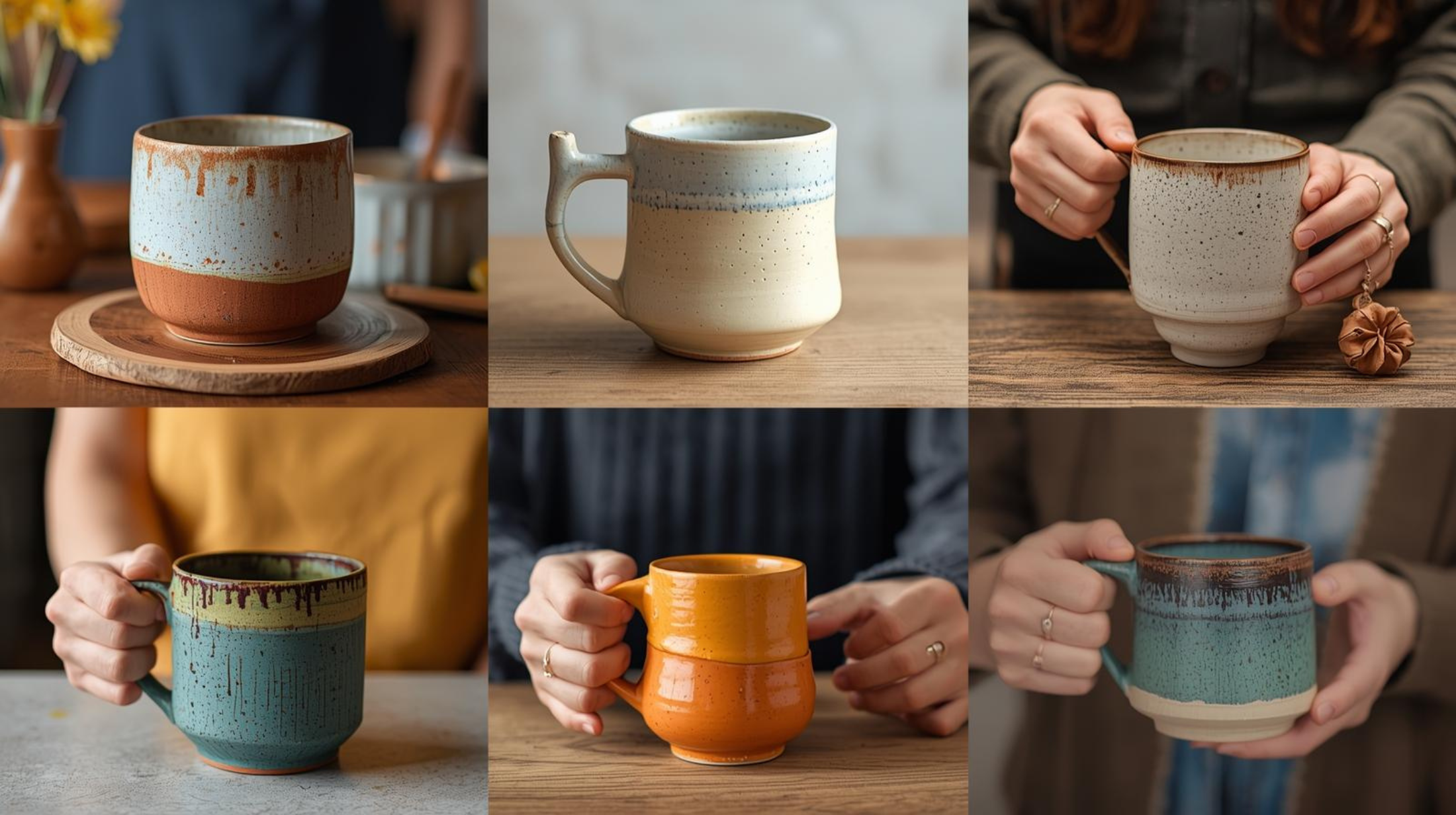
Artisan Spotlight: The Makers Behind the Mugs
Handmade mugs aren’t just drinkware they’re personal stories shaped in clay, glass, or wood. Each mug carries the imprint of its maker, their philosophy, and their craft traditions. By understanding the people behind the pieces, you not only connect with the art but also appreciate the care and authenticity in every sip.
From Clay to Cup: A Potter’s Journey
Meet Amira Hassan, a UAE-based ceramic artist whose mugs combine modern minimalism with Middle Eastern design heritage. Amira describes her process as “a meditation in motion” from hand-kneading clay to the final glaze firing.
“My goal is to create pieces that bring a moment of quiet beauty to someone’s busy day. Every ridge and curve tells a small part of that story.” – Amira Hassan
- Style & Philosophy: Clean lines with subtle geometric patterns inspired by Islamic architecture.
- Creative Process: Uses local clay, hand-thrown techniques, and natural glazes for a sustainable approach.
- Where to Find Her Work: [Amira’s Online Studio Shop]
Sculptural Elegance: Turning Mug into Art
Luis Romero, a Spanish-born artisan now working in Dubai, creates mixed-media mugs that blur the line between functional ware and sculptural art. Each piece tells a bold, artistic story.
“For me, mugs are everyday canvases art you can hold, sip from, and start your morning with.” – Luis Romero
- Style & Philosophy: Statement mugs featuring wood handles, metallic accents, and asymmetrical silhouettes.
- Creative Process: Combines traditional wheel throwing with hand-carved detailing and metal inlays.
- Where to Find His Work: [Luis Romero Ceramics Gallery]
Tradition Meets Modern Living
In contrast, Ayesha Khan, a Pakistani artisan working with stoneware, honors her family’s three-generation pottery legacy. Her handmade mugs are rooted in traditional craft but adapted for modern durability.
“Every mug I make carries a part of my family’s history. I want people to feel the warmth of tradition in a piece they use every day.” – Ayesha Khan
- Style & Philosophy: Rustic finishes with earth-tone glazes, built for both everyday use and heirloom value.
- Creative Process: Hand-thrown, wood-fired kilns, and natural ash glazing.
- Where to Find Her Work: [Ayesha’s Artisan Pottery Store]
Frequently Asked Questions About Handmade Mugs
- Address common queries and concerns readers might have regarding handmade mugs, their care, and acquisition.
- Audience Pain Points Addressed: All previously mentioned pain points can lead to FAQs.
- Common Queries:
- Are handmade mugs dishwasher and microwave safe? (Reiterate material-specific care).
- Why are handmade mugs more expensive? (Value proposition, labor, materials).
- How do I know if a mug is truly handmade? (Revisit quality indicators).
- Can handmade mugs chip or break easily? (Durability vs. care).
- What’s the difference between ceramic and pottery?
- How do I remove coffee/tea stains from my handmade mug?
- Are all glazes food-safe?
- Can I put a handmade mug in the oven?
- What’s thermal shock and how do I avoid it?
- Expert Answers: Provide clear, concise answers, referencing previous sections or expert tips where applicable.
Conclusion: The Art of Daily Ritual
- Summarize the value and joy of owning handmade mugs, encouraging readers to embrace craftsmanship in their daily lives.
- Recap Key Benefits:
- The unique character and story each mug holds.
- The enhanced sensory experience of using a thoughtfully crafted item.
- Supporting independent artisans and sustainable practices.
- The satisfaction of owning something truly special and distinct.
- Encourage readers to explore the world of handmade mugs, discover their perfect piece, and elevate their daily rituals.
- Invite them to embrace the small joys that come from appreciating true craftsmanship.
- Differentiation Opportunity: Reiterate how handmade mugs become functional art and cherished objects.
